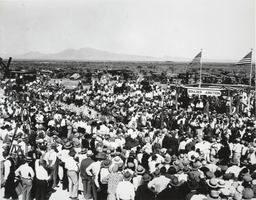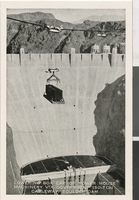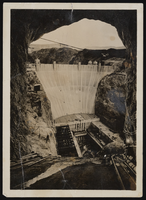Search the Special Collections and Archives Portal
Search Results
Louise Riley oral history interview
Identifier
Abstract
Oral history interview with Louise Riley conducted by Bryan Neel on March 27, 1979 for the Ralph Roske Oral History Project on Early Las Vegas. In this interview, Riley discusses her life after moving to Boulder City, Nevada in 1946, and later moving to Las Vegas, Nevada. Riley describes dates with her husband on the Las Vegas Strip, which included visiting clubs or watching Liberace perform. Riley also discusses her husband's job as an accountant at the Hoover (Boulder) Dam, as well as briefly discussing her experiences viewing nuclear weapons tests.
Archival Collection
Teresa Jones Denning oral history interview
Identifier
Abstract
Oral history interview with Teresa Jones Denning conducted by Lynn Ballard on February 26, 1977 for the Ralph Roske Oral History Project on Early Las Vegas. Denning first discusses living on a farm and her education in Overton, Nevada. Denning also talks about the construction of Hoover (Boulder) Dam while living there, her work as a bus driver for Las Vegas High School and the changes in Boulder City, Nevada over time.
Archival Collection
Kenneth Ousley oral history interview
Identifier
Abstract
Oral history interview with Kenneth Ousley conducted by Patricia van Betten on October 02, 2009 for the History of Blue Diamond Village in Nevada Oral History Project. In this interview, Ousley discusses his personal history and moving to Blue Diamond, Nevada with his family. He talks about the work his father did as a miner at the Blue Diamond Mine and describes life in the village during the 1930s. Ousley recalls his visits to Las Vegas, Nevada and the construction of Boulder Dam (Hoover Dam). Lastly, Ousley talks about Cottonwood Ranch and the Blue Diamond school.
Archival Collection
Lee Murialdo oral history interview
Identifier
Abstract
Oral history interview with Lee Murialdo conducted by Kim Burco on February 26, 1979 for the Ralph Roske Oral History Project on Early Las Vegas. In this interview, Murialdo discusses the history of Las Vegas, Nevada as it pertains to casinos and city growth. Murialdo describes the initial founding of the city and origins of the name "Las Vegas," entertainment on the Las Vegas Strip, and the different games available to play in casinos. Murialdo also describes the construction of the Flamingo Hotel and Casino, as well as the construction of the Hoover (Boulder) Dam. Murialdo goes on to discuss her novel and why she decided to move to Las Vegas.
Archival Collection

Photograph of ceremony celebrating Hoover Dam construction, September 17, 1930
Date
Archival Collection
Description
Image

Hoover Dam Postcards, Image 014
Date
Description
Image
Earl, Samuel S., 1912-1999
Sam S. Earl was born February 9, 1912 in Virgin, Utah. He moved to Las Vegas, Nevada in 1928 for a few months, then returned home in Utah. He returned to southern Nevada in 1935 to work during the Hoover (Boulder) Dam days. Earl and his wife lived in a tent until he built a little two-room house for his young family to reside. Earl ended up moving to various cities around southern Nevada until 1945 when he moved to Henderson, Nevada. His career was filled with working as a building contractor, truck driver, and painter. Earl passed away January 4, 1997.
Person
Kenneth W. Swallow oral history interview
Identifier
Abstract
Oral history interview with Kenneth W. Swallow conducted by Cynthia Brannon on March 11, 1975 for the Ralph Roske Oral History Project on Early Las Vegas. In this interview, Swallow discusses his personal history and the history of Southern Nevada. Swallow describes moving to Boulder City, Nevada during the 1940s and his career working for the postal service. Swallow goes on to describe prominent figures who visited the Hoover (Boulder) Dam, his involvement in organizations, recreational activities, and nuclear testing. He concludes by discussing the history of Basic Magnesium Inc. and the city of Henderson, Nevada, and how Boulder City has developed and changed.
Archival Collection

Transcript of interview with Elton Garrett by Alan Gurwitz, March 1, 1981
Date
Archival Collection
Description
On March 1, 1981, Alan Gurwitz interviewed Elton Garrett (born 1902 in St. Joseph, Missouri) about his experiences in Southern Nevada and more specifically his work in Boulder City. Garrett first talks about the development of Boulder City from its inception in 1931 and how it has grown throughout nearly fifty years. He also discusses his work in journalism for the Boulder City Journal, the building of Boulder Dam, and atomic testing at the Nevada Test Site. The second part of the interview involves a discussion of the founders of Nevada Southern University, Garrett’s work on legislative committees, and his work as a schoolteacher and school principal. The interview concludes with Garrett’s thoughts on the future of Boulder City and its continued growth.
Text

Boulder (Hoover) Dam, image 001: photographic print
Date
Archival Collection
Description
Image
